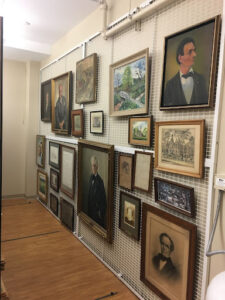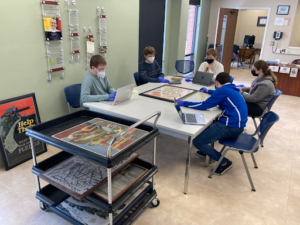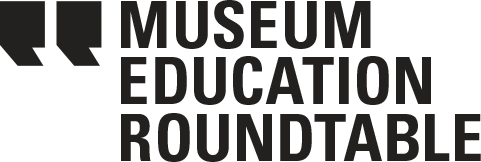The Big Picture: Balancing Collections Care and Access with Project Design and Student Engagement
Professionals in arts and cultural heritage organizations, whether at large institutions or smaller ones, manage the delicate balance between utilizing collections and meeting their preservation requirements. Academic museum and gallery professionals balance the demands of collections use and care while meaningfully supporting student success. Educators practicing within these spaces call upon a dynamic skillset to engage audiences and foster opportunities for discovery and dialog, advancing critical conversations about diversity and inclusion. Utilizing project design to engage students as active stakeholders with collections stewardship is one way educators may strike a balance of collections care and access.

Established in 1829, Illinois College is the oldest degree-granting institution in the state. In 2014 the college secured a National Endowment for the Humanities Grant, allowing the development of a state-of-the-art storage facility and new leadership of the campus museum and archives with the hire of Samantha Sauer. With the mission to collect, preserve, and share collections while serving the parent organization, there was rich promise and potential to engage the campus community with collections. In 2021 Madison Pierson was selected as the college’s Public History Fellow, a one-year position designed for emerging professionals. In spring 2022, Pierson led a multifaceted project with the college’s art collection. Shortly after the facility first opened, Sauer had surveyed the art collection and found it inaccessible, lacking basic physical and intellectual control. Initial art storage within the facility was not efficient. Artwork selected for vertical storage was not intentional in subject matter, style, medium,or artist, and no condition reports or formal review of material had been conducted. Art stored in crowded bay and oversized storage areas lacked identifying information and was difficult to access. Limited material organization also impacted on-site visitor experience when touring storage as part of admission events, class sessions, research visits, and donor and VIP tours.

Pierson and Sauer first needed to define the scope of the project and available resources. The art collection required basic intellectual and physical control. Objects already hanging on the vertical storage wall, as well as select material in bay storage and off-site museum storage would be included in the survey. Fragile framed objects housed elsewhere in the new facility were not included. Pierson and Sauer identified key goals for the project, focused on establishing and increasing access by creating a digital inventory, rehousing, photographing, and tagging material, and designing and installing an updated layout to vertical storage. They also identified a small dedicated team of Archives and Museum Student Assistants to work with Pierson once a week on the project. By 2021, the student work program in the museum and archives was established and complemented additional forms of collections engagement such as public programs, internships, a public history concentration, and student-faculty research. Highly competitive, the program engaged students from across academic disciplines for paid hourly positions, and all positions incorporated core learning objectives and competencies. Alongside collection priorities, leaders prioritized transferable learning objectives for student assistants on the project, focusing on teamwork, data management, and communication.
The project was split into three phases over the term: survey, curation, and installation. During the survey phase, a living document for inventory and condition reporting was designed and implemented. Over the course of several weeks, the student team learned art handling best practices while taking measuremoents, writing descriptions, capturing photos, and assigning object identification numbers. Students became familiar with controlled vocabulary standards while describing material conditions and creating and updating metadata. Written and verbal communication skills were continuously refined across the project team.

Following the completion of the inventory, the team created a short list of material to include in hanging storage during the curation phase. Students were given the opportunity to advocate for a work to include on the wall, increasing their sense of ownership of the project. When narrowing down the list of potential material to include within the space, the team evaluated media, subject matter, size, and condition alongside institutional and departmental conversations focused on diversity, equity, inclusion, and accessibility. The short list featured framed photographs, manuscripts, portraits, posters, and paintings.
To limit material handling, Pierson made a scaled diagram using the free version of Canva to visualize different layouts, with the goal of finding balance between interpretation and maximizing storage. The team paid particular attention when selecting works that would hang on a small portion of the rack that extended beyond the space’s mobile shelving units and would therefore always be visible. Time for team discussion – and debate – was built into weekly shifts to allow for thoughtful review and reflection. In order to combat project fatigue, Pierson also reassigned students to support other initiatives, such as research requests, rehousing collections, supporting ongoing digitization, or pulling material for research appointments.

The final phase of the project was installation. During a single shift, the team collaborated with additional staff to safely and efficiently complete installation. Pierson then created a diagrammed label for the wall, incorporating a QR code for collections staff to access the digital inventory. Throughout the project, Pierson and Sauer connected during regular check-in meetings and dedicated project strategy sessions to track and document progress, focusing on opportunities for student reflection and celebrating project benchmarks with digital outreach and social media engagement.

Team discussions during each phase of the project focused on the collection scope. Now that there was an inventory, what was missing? What stories were not represented? How could gaps be prevented moving ahead? Discussion while measuring, photographing, and installing the collection served to connect students’ short-term collections management tasks with broader departmental collections development, community outreach and engagement, and DEIA scholarship.
Pierson and her team invested approximately 85 hours on the project. Completion of the project dramatically increased both physical and intellectual control of the art collection. Rearranging vertical storage increased hanging capacity by over 20%. The new vertical storage display created a more cohesive narrative and, importantly, shared a more diverse representation of subject matter and material from the collections, which aided in sharing institutional knowledge with both one-time and repeat visitors. The team also safely reorganized and rehoused materials in oversized and bay storage across the facility. In addition to addressing critical collections management needs, the Archives and Museum Student Assistants refined and honed a number of transferable skills includ

ing teamwork, data collection, time management, art handling, applied math skills, and communication. For Sauer, the project also advanced multi-year strategic planning, mindful project design, and directly supported student success in a welcoming and inclusive work and learning environment.
As the Public History Fellow, Pierson learned how to lead a focused project team while balancing other institutional projects and priorities. Additionally, the project allowed Pierson to explore professional interests while developing important hands-on skills in art handling and art collections management. Pierson continues to utilize skills acquired through the Public History Fellowship; she currently works with Lawrence University’s art collection of over 6,000 objects. The project informed Pierson’s approach towards maximizing use of Lawrence’s storage spaces, which include 24 double-sided vertical storage racks. Beyond practical art handling and storage skills, the project also influenced how Pierson collaborates with students to support institutional goals through hands-on projects.

Work and scholarship with the art collection in 2022 continues to serve and support students and the campus community today. Vertical storage now functions as an efficient storage method while enriching behind-the-scenes visits to the collections. The inventory serves as a sustainable resource for collections access, ongoing and new digital preservation initiatives, research, staff, and donor engagement. To learn more about campus collections at Illinois College, contact Elizabeth Ray, Illinois College Archivist and Curator of Special Collections. ([email protected])
Madison Pierson was the 2021-2022 Public History Fellow at Illinois College. She currently serves as the Collections and Gallery Assistant for the Wriston Art Galleries at Lawrence University.
Samantha Sauer led the museum and archives at Illinois College from 2016-2022, and she currently serves as the Director of Collections Care and Access with the Wisconsin Historical Society. Sauer participated in the Museum Education Roundtable’s 2023 Writing Workshop “Practitioners as Scholars.”

